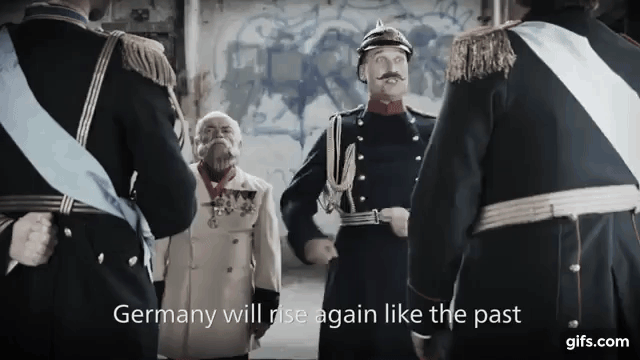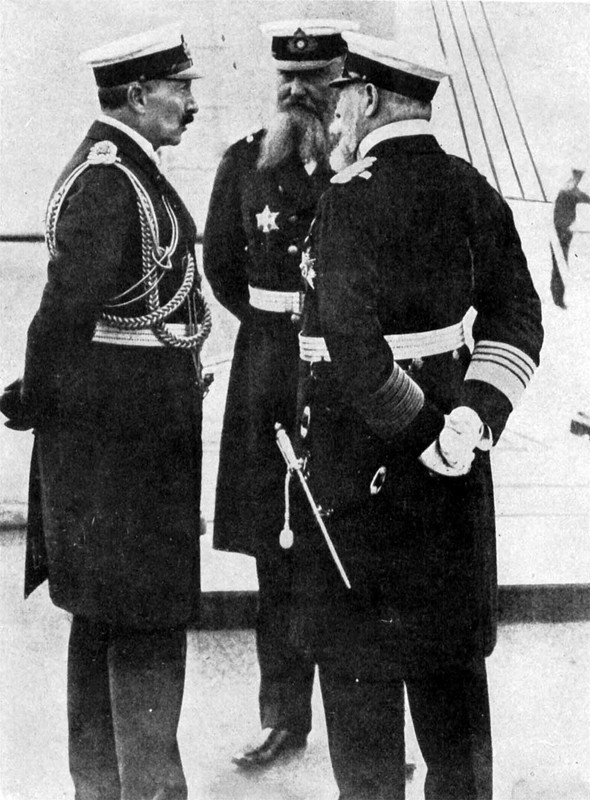 "After the
"After the Finlandschlacht
, His Majesty was very angry with the performance of the Kaiserliche Marine
. We had promised His Majesty a quick, decisive victory and had failed to deliver it. This was partly because of the incomplete training of our crews and, for that, the responsibility lay solely upon the Admiralität
. But a significant part in the inconclusive battle was also played by the weather, which had prevented us from properly acquiring targets, even at extremely close ranges."More significantly, it became evident that positioning our ships in such a way as to maximise the number of ships firing on a single target was not a viable tactic. I can confirm that, during the battle, it was impossible to distinguish the splashes of Hertha's
shells from those of Victoria Louise
, or even the light cruisers! We had to instruct our officers to adopt a 'duelling' approach. Each ship's commanding officer was instructed to select targets that were currently unengaged above all others."But His Majesty harangued and criticised the Admiralität
most severely for what he perceived to be our failings; and insisted that the Fleet pursue a more agggressive stance. In all frankness, this was the Admiralität's
opinion also. Thankfully, His Excellency, the Herzog
championed our cause to a considerable degree."
-Vizeadm. Galster K (post mort.) 1956, The Naval Question: Collected Papers and Letters, edited by Dr. Ernst Jablonka, Universitätsverlag Heidelberg.

No, Wilhelm wasn't pleased
at all; but both von Bülow and von Mecklenburg laboured separately to support the
Admiralität. Von Mecklenburg, in particular, invited the Admirals once more to his Berlin residence and requested that they point out what they thought the main problems with the German tactics so far had been. By this point, both von Tirpitz and Galster perceived the
Herzog as a political ally; and were eager to discuss their future plans. Von Mecklenburg had firmly established himself as a supporter of the
Kaiserliche Marine - even more so, when, in a callback to his Colonial service, he funded the dredging up of Tanga's military harbour, with the goal of converting it into a major coaling station for the colonial fleet.
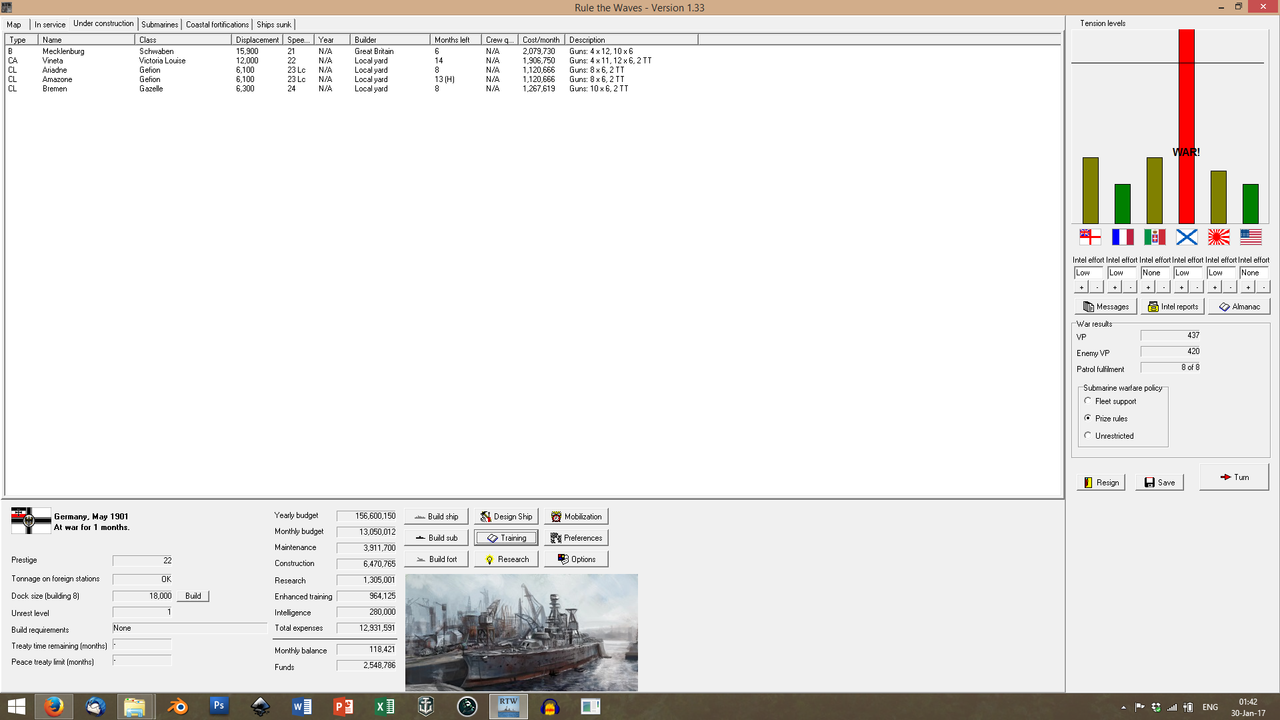
With
Mecklenburg only six months away from completion, the
Admiralität played a game of cat-and-mouse with the Russian Fleet, buying time.

In early June, the Russian cruiser
Nadezdha managed to sneak into German territorial waters and sank the freighter
Rheingold.
This was the straw that broke the camel's back. With the German and Russian armies bogged down in tentative jabs and forays, Wilhelm ordered that the
Flotte mobilize in full and "teach those
Gotverdammte Russians their place."
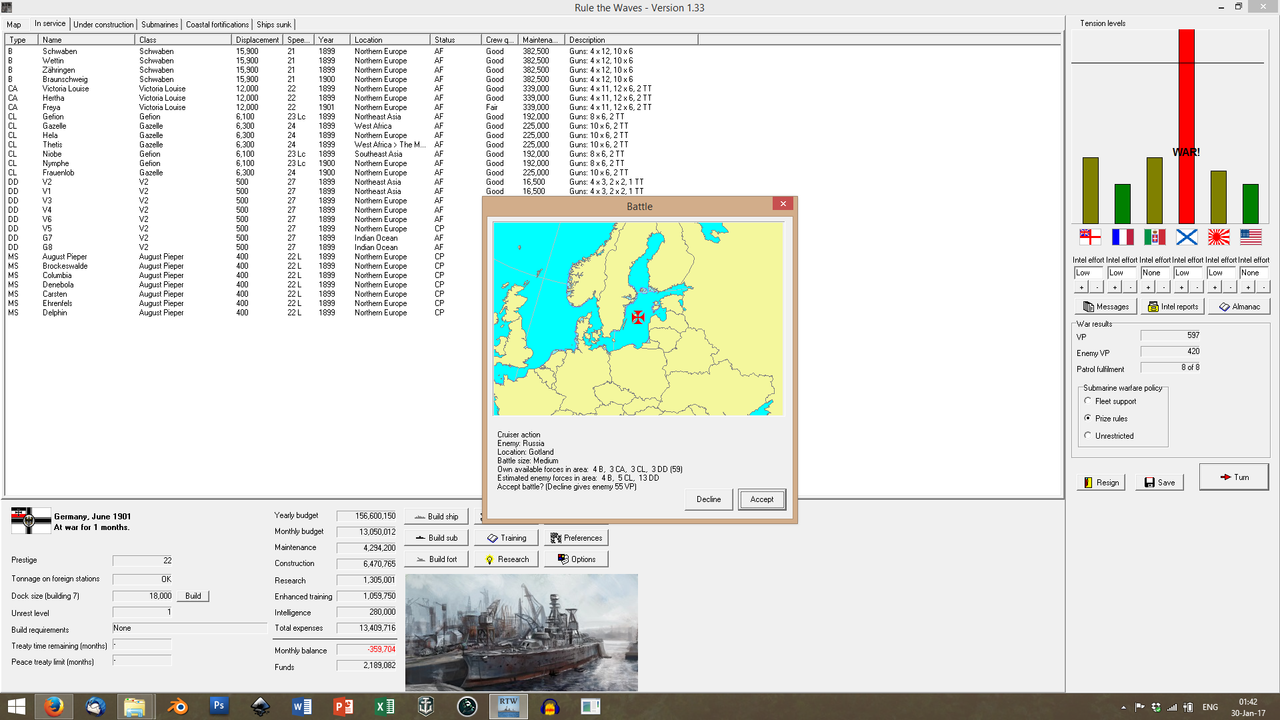
Tirpitz was hesitant about commiting the battlefleet; but Galster employed his cruiser forces to great effect. On the 15th of June,
Hertha and
Freya engaged three Russian light cruisers in the Baltic Sea.
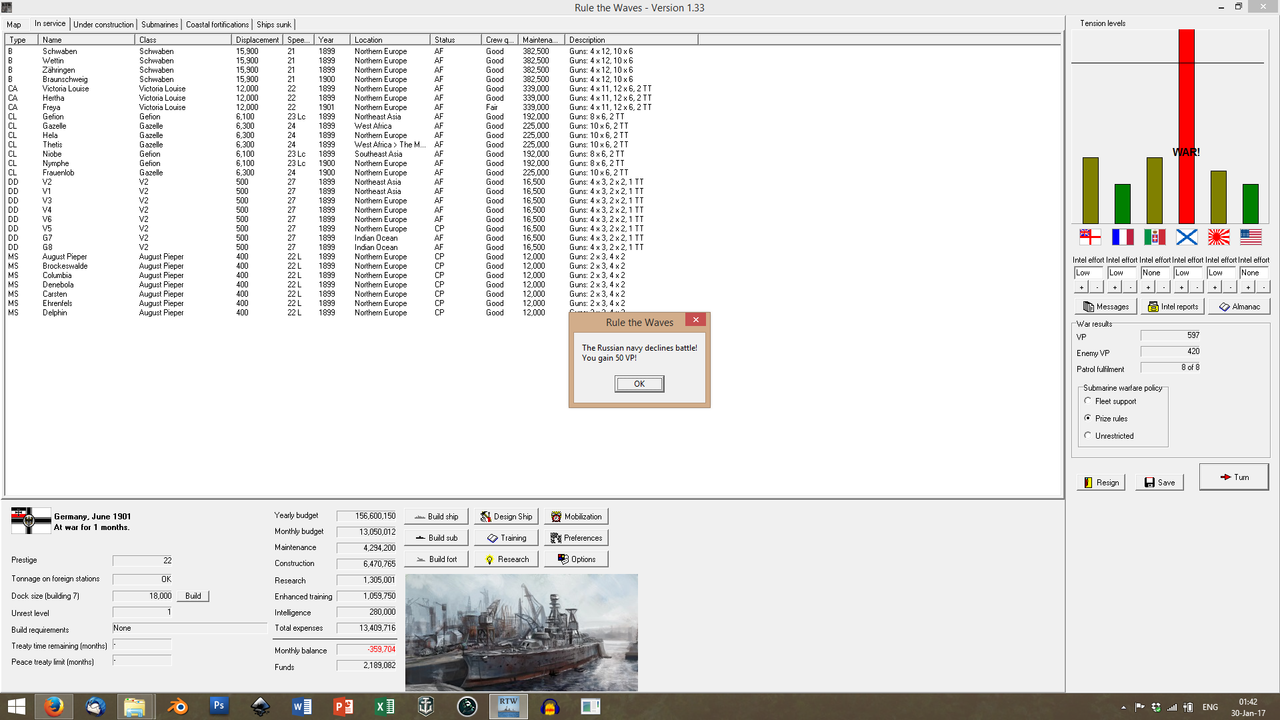
The Russians turned and ran under fire, denying battle; this cheered up Wilhelm to some extent.
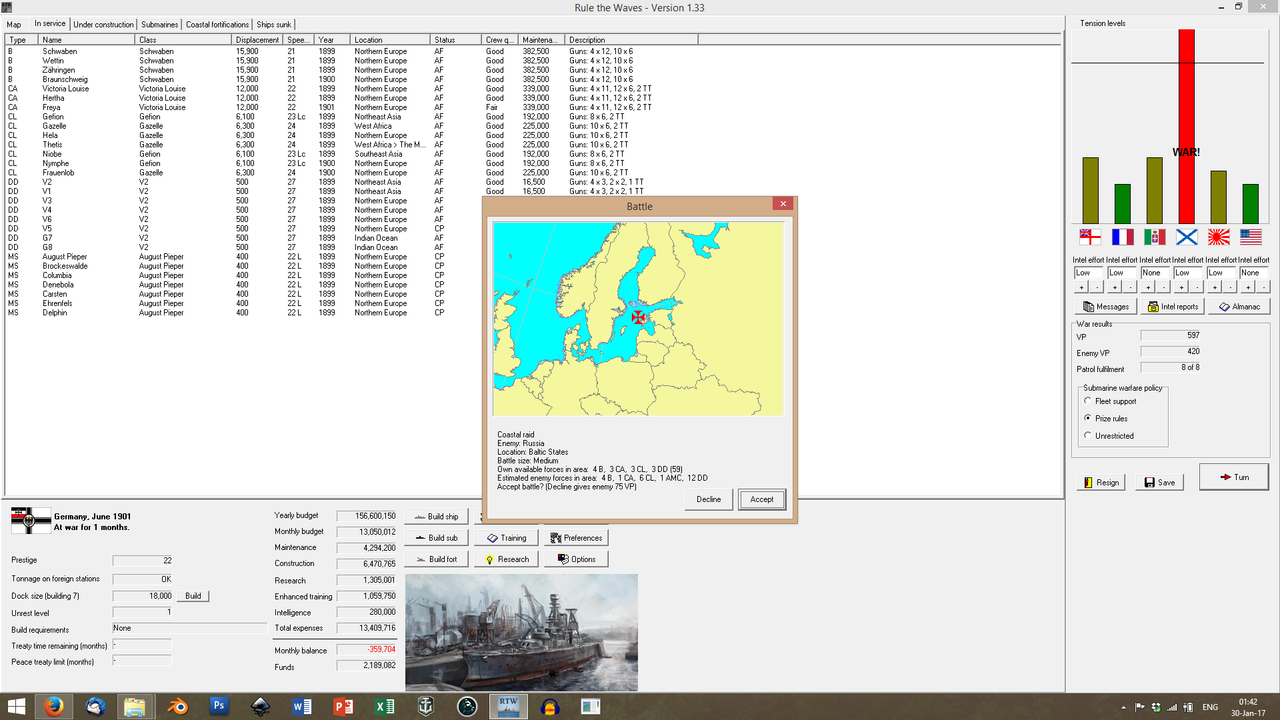
It also emboldened Galster. For a followup, he led
Hertha and
Victoria Louise, accompanied by
Frauenlob and three
Zerstörer to Saaremaa.
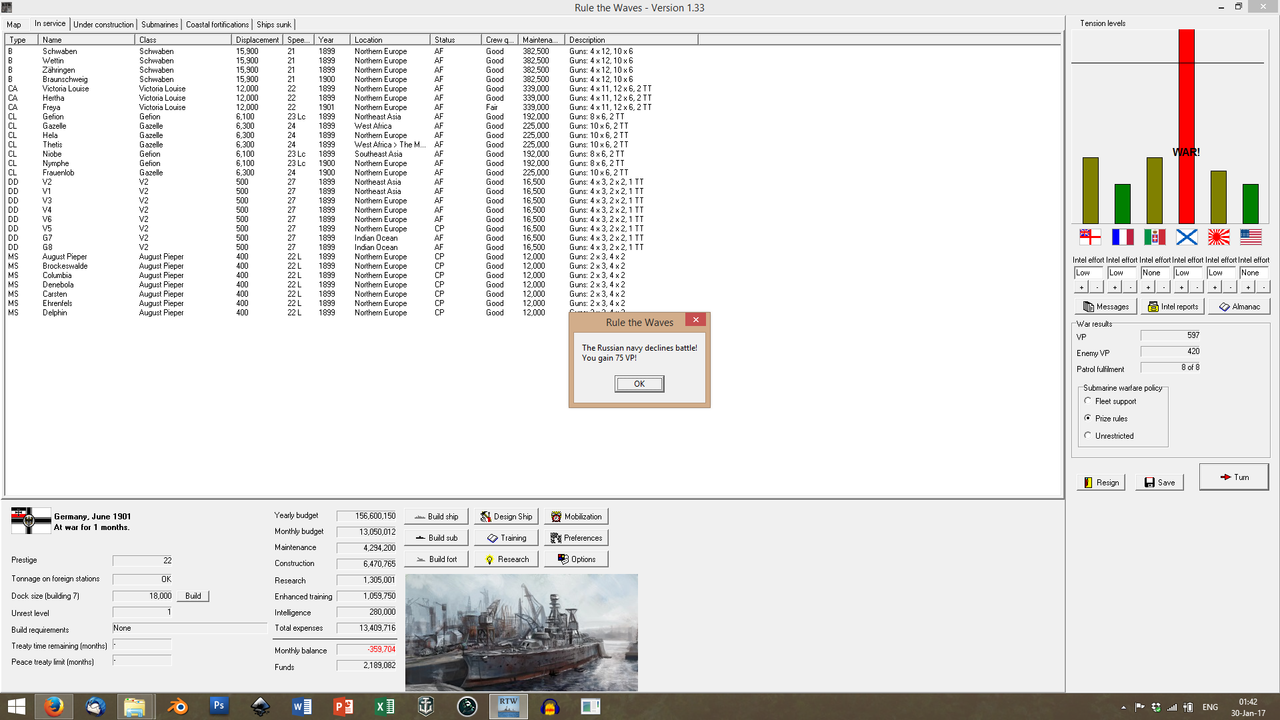
There, he bombarded Russian coastal fortifications and sank four merchant vessels, avenging the
Rheingold with added interest. Wilhelm, mollified, acknowledged the value of lighter forces for the first time; and allowed von Meclenburg to award Galster with the Grand Commander's Cross of the Order of the Griffon for his service, on behalf of Mecklenburg-Schwerin.

Tirpitz could not allow Galster to take all the glory. On the 17th of July, he sent out the entirety of his battlefield on a daring raid on Russian shipping, near Bornholm.

This time, the Russians responded.
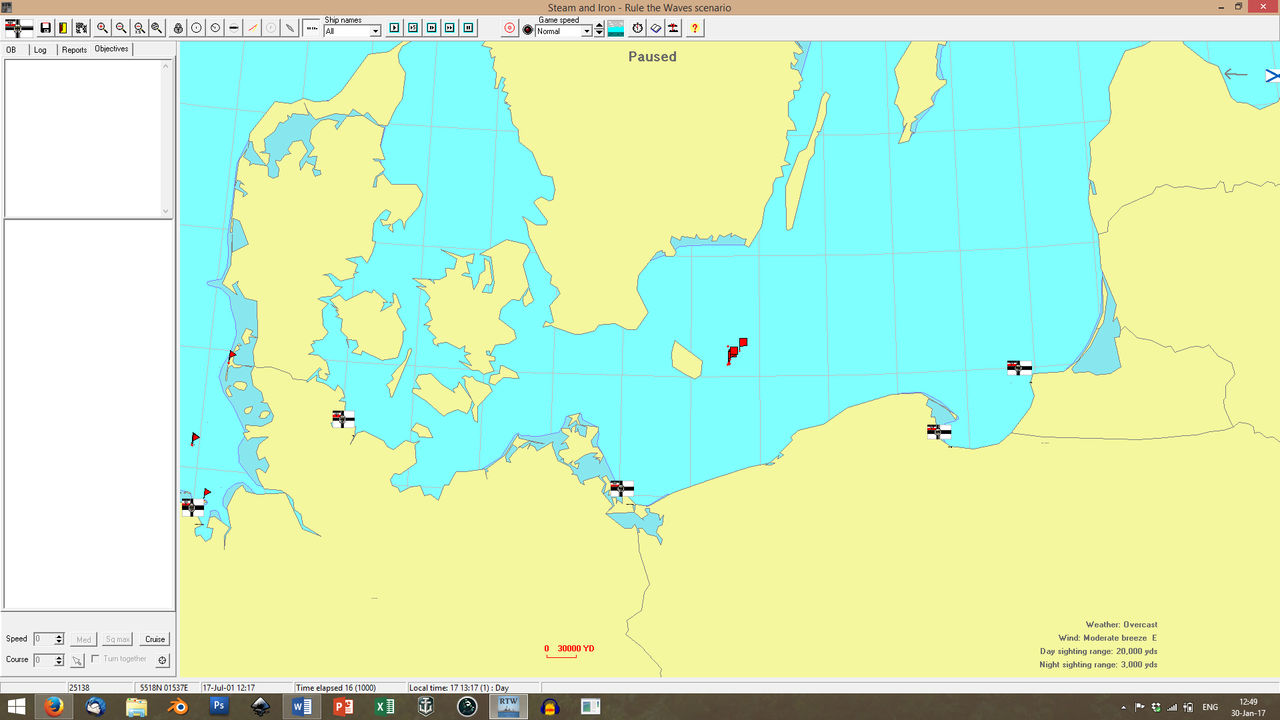
The time is a quarter past noon, just to the east of Bornholm. The entirety of the German battleline is present, escorted by Galster's cruisers.
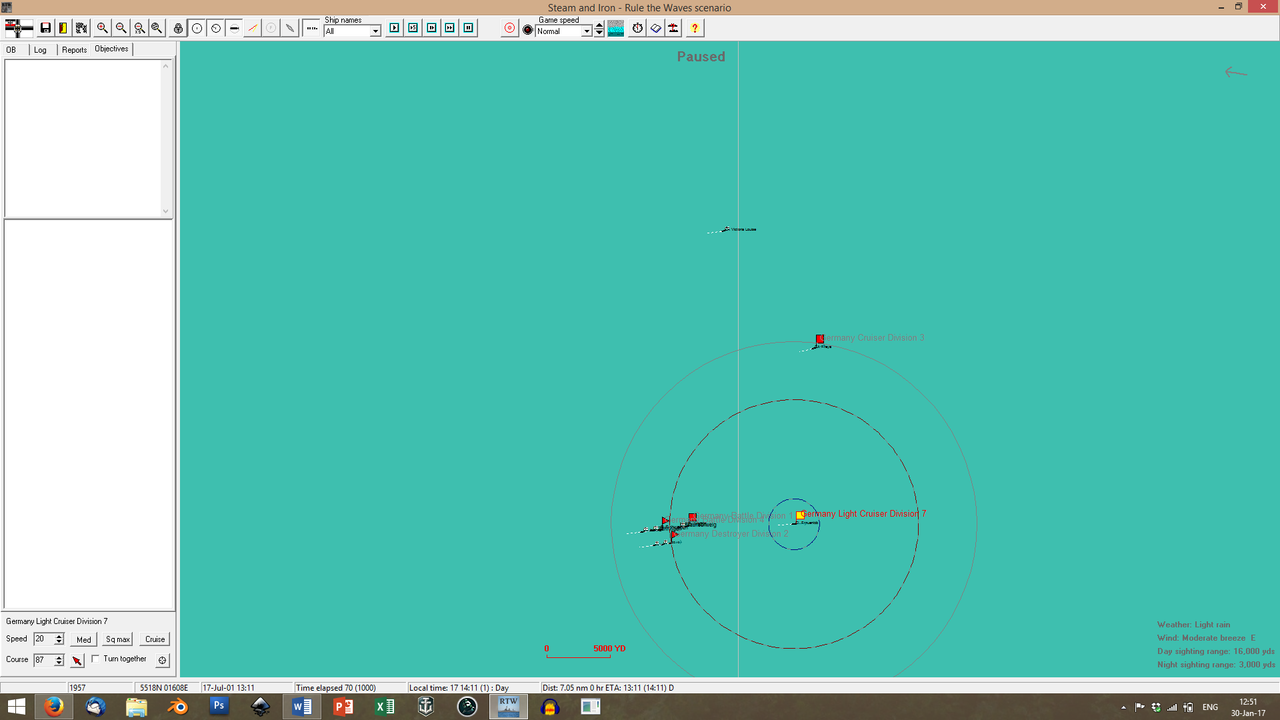
The weather, unfortunately, is, once again, overcast; and it is raining lightly. Visibility is...less than ideal. A stiff breeze blows from the east.
The
Frauenlob,
Victoria Louise and
Freya are spread out in front of the fleet, as a scouting element. This time around, Galster is holding his flagship,
Hertha, in reserve, near the battleships.
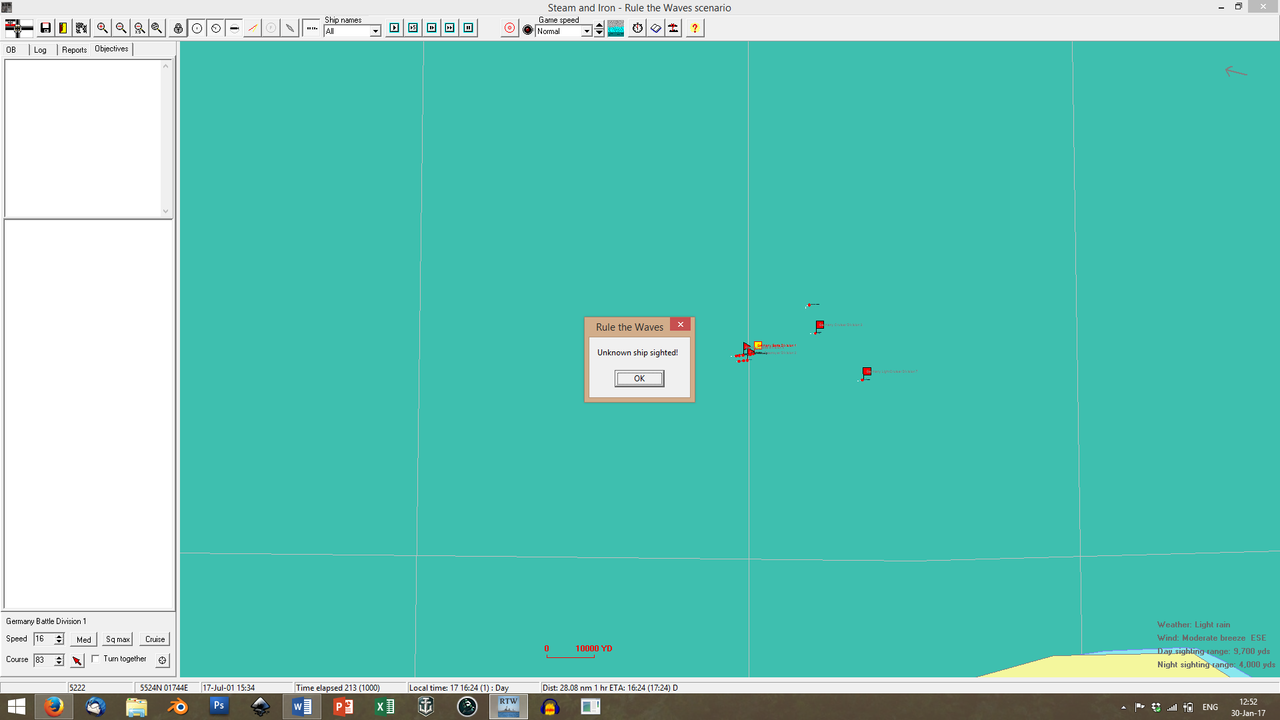
15:34: Contact!
Victoria Louise spots an enemy capital ship emerging from a nearby fogbank.
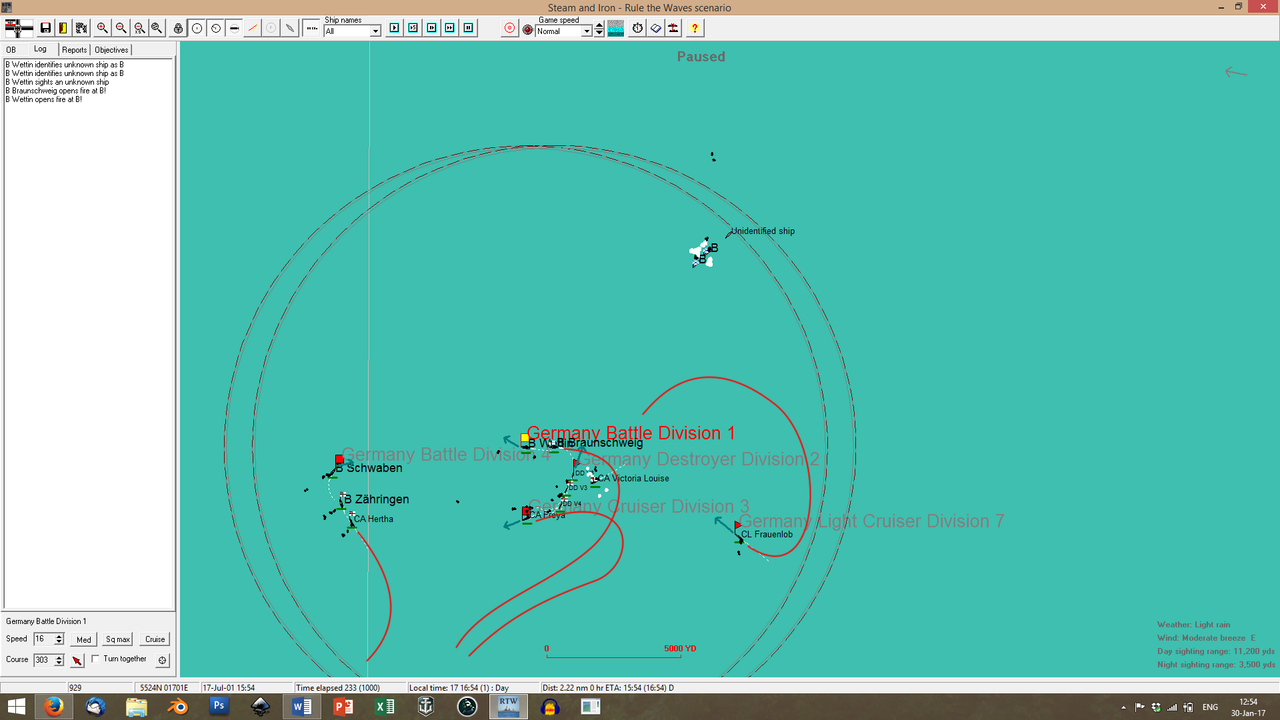
Scratch that -
two capitals. The Germans immediately re-arrange their fleet. The scouting elements fall back; the battleships maneuver to form line of battle.
Wettin fires the first shot!

Ten minutes later, the secondaries of
Wettin score first blood. This time around, the firing discipline of the Germans is much improved; each of the German battleships is engaging a different enemy capital.
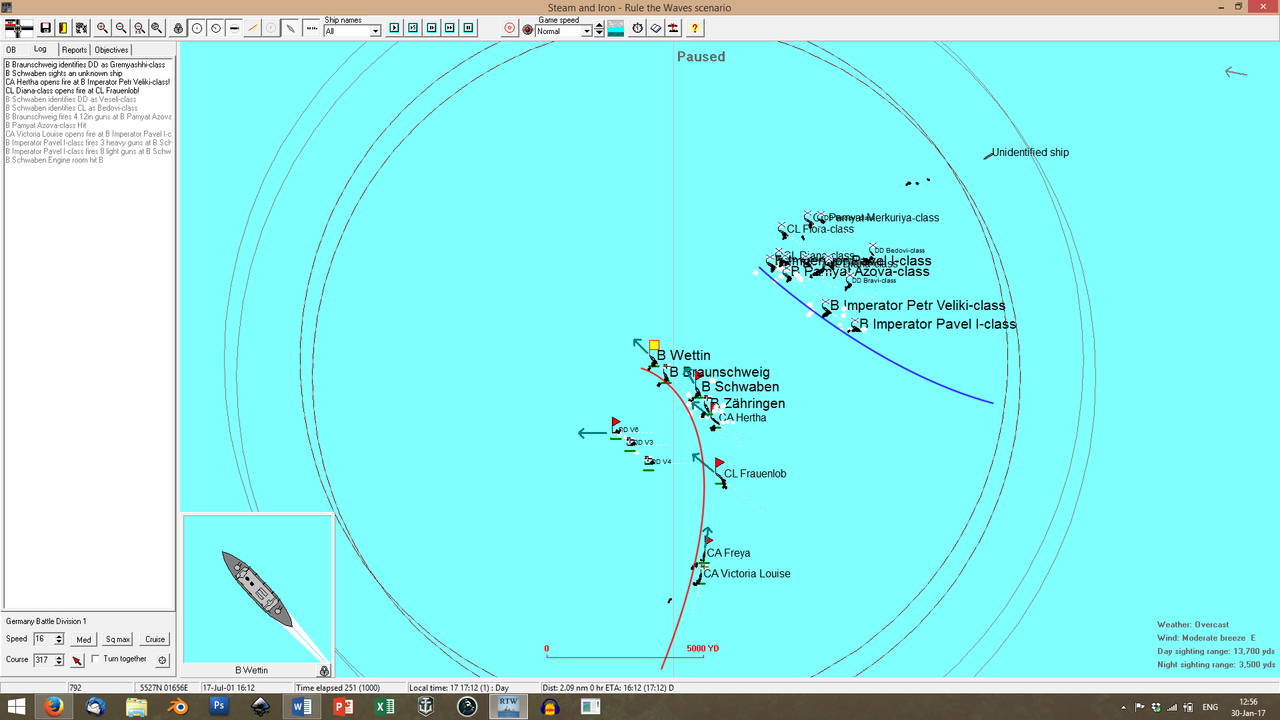
The two battle-lines thunder at each other at under 5,000 yards. Both fleets are holding formation for now; but the German heavy cruisers are almost ready to lend their own fire to the line.

16:22.
Wettin peppers one of the
Pavels with secondary fire; she receives a hit in return, but her armor holds strong.
Hertha, on the other hand, is hit by incendiary ammunition; her superstructure bursts in flames.
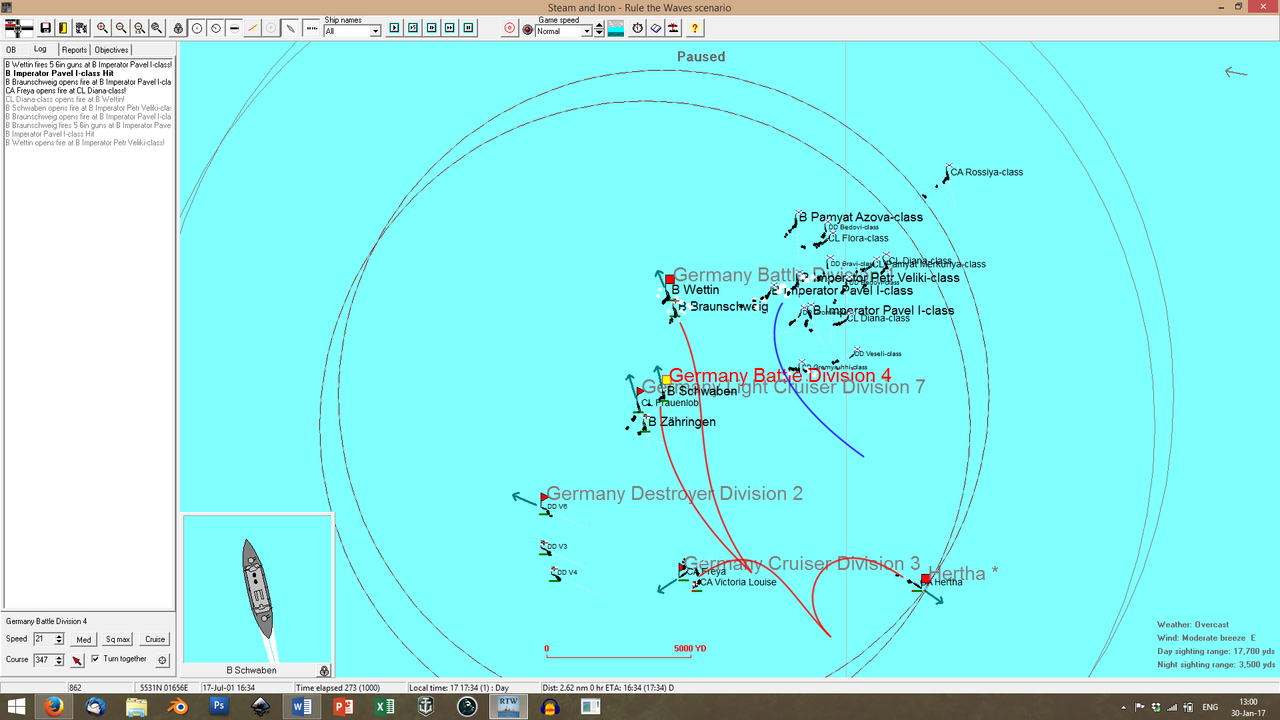
Galster curses bitterly and signals the
Victoria Louise to assume command of the cruiser forces;
Hertha pulls out of the battleline and cuts her speed, to allow damcon crews to get to work fighting the flames.
Wettin keeps up the withering barrage of secondary fire on the
Pavel.

16:44. The fire on
Hertha is extinguished and Galster orders flank speed and rushes to rejoin the line. Further to the north,
Braunschweig scores a main battery hit on the
Petr Veliki; and
Zähringen strikes the second
Pavel.
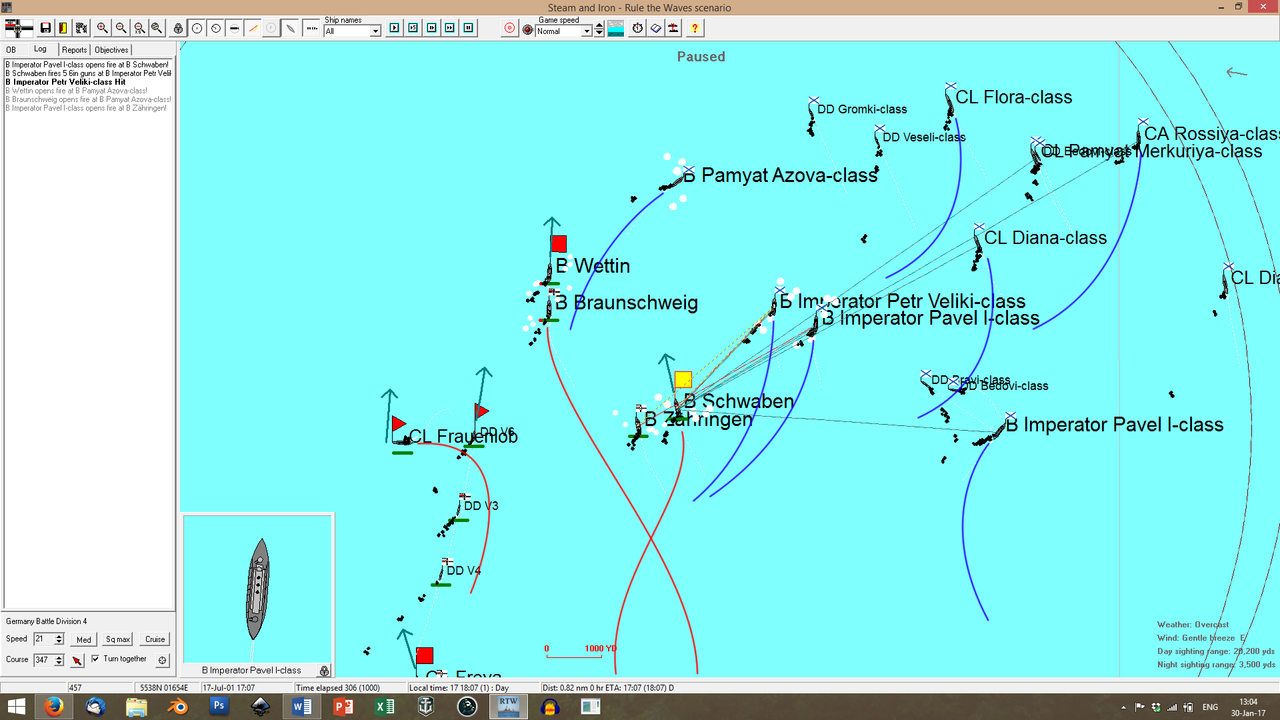
Büchsel will not be denied this time around. The battleships serpentine in parallel with the Russian fleet; presenting alternating good and bad targets. This confuses the Russian gunners.
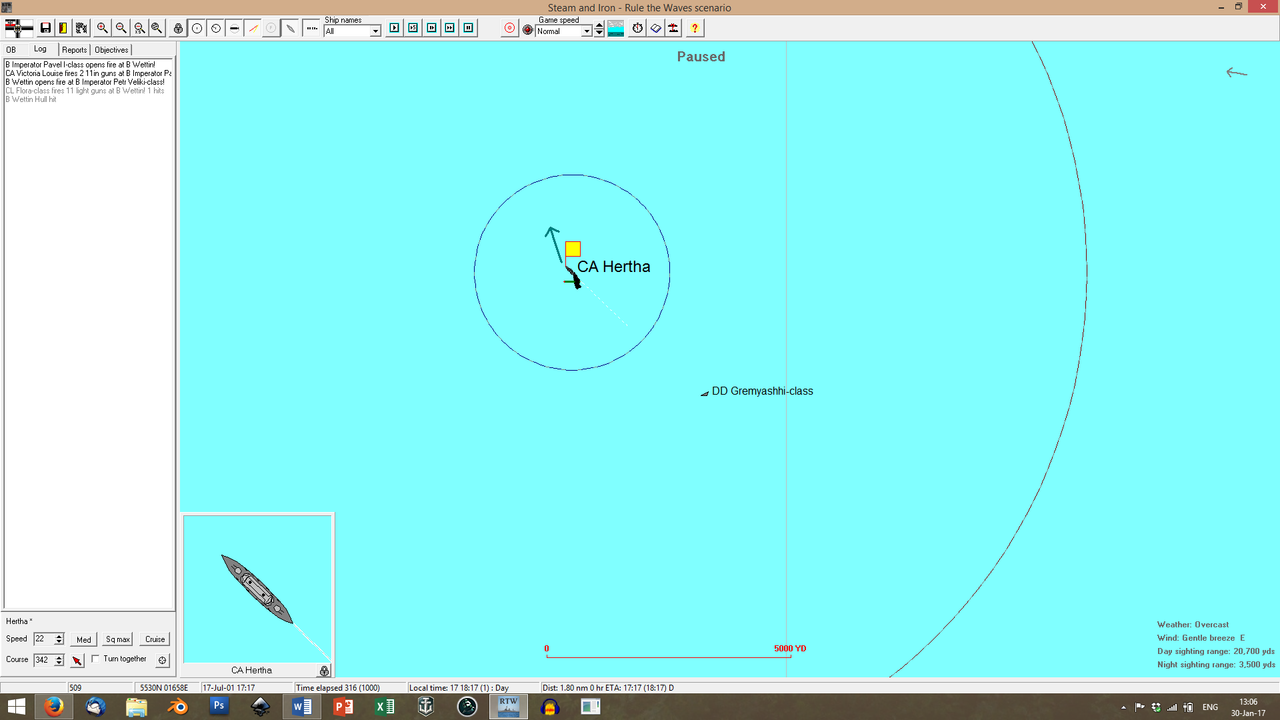
Meanwhile, during his mad rush to rejoin the battle-line, Galster runs across a Russian torpedoboat, that charges in for an attack. The entirety of
Hertha's starboard secondary and tertiary battery erupts in fire and thunder. The
Gremyashchy-class destroyer is blown out of the water and
Hertha plows on, undaunted and unslowed.
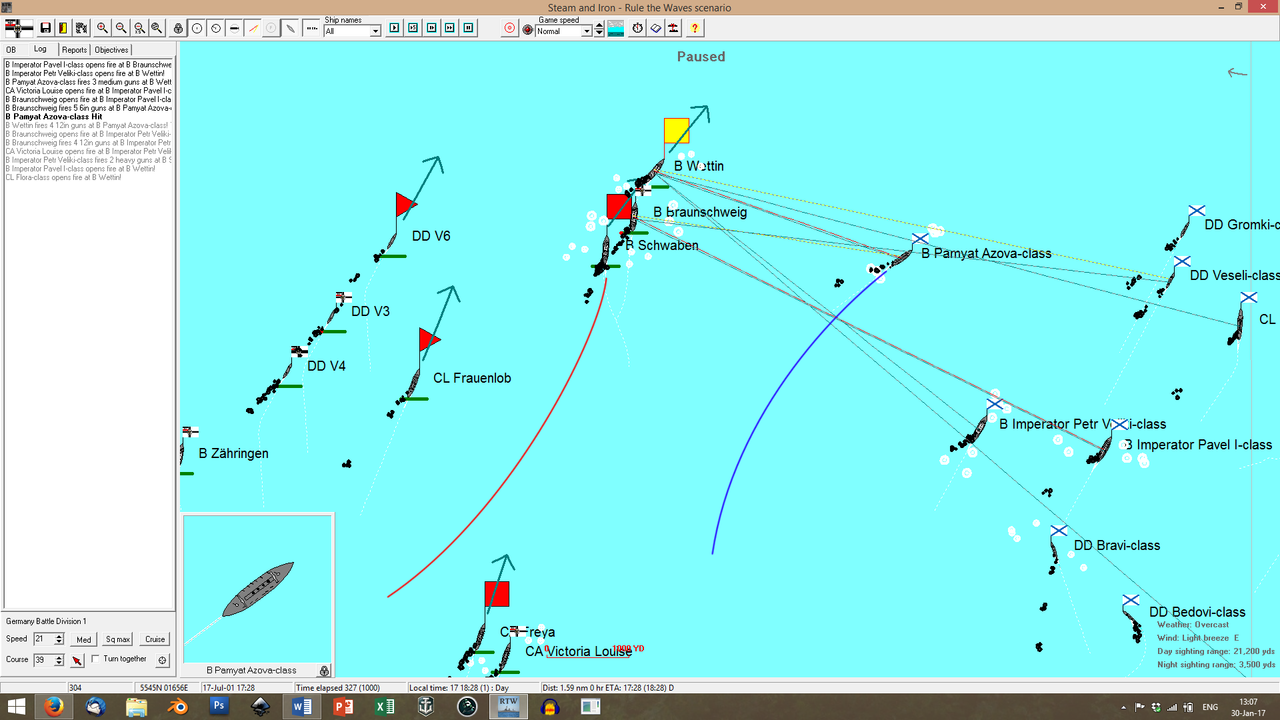 Wettin
Wettin,
Braunschweig and
Schwaben are closely engaging the Russian fleet;
Zähringen has fallen behind, for unknown reasons. Büchsel curses bitterly, for he is now outnumbered. Even worse,
Zähringen is firing at the
Pamyat Azova and messing up
Wettin's targeting.

The pursuit continues. Once again, the
Schwaben-class' high speed helps the Germans dictate the battle.

18:40. Büchsel notes that the
Petr Veliki is losing speed. He sees an opportunity and hoists the 'flotilla attack' signal. The three
Zerstörer V3, V4 and
V6 swing to the attack. Unfortunately,
V6 is
immediately struck by one of the
Pietr Veliki's secondaries. Her single torpedo explodes on her mount. The ship shudders; but her machinery is still operational and she continues her mad charge, as bait if nothing else.
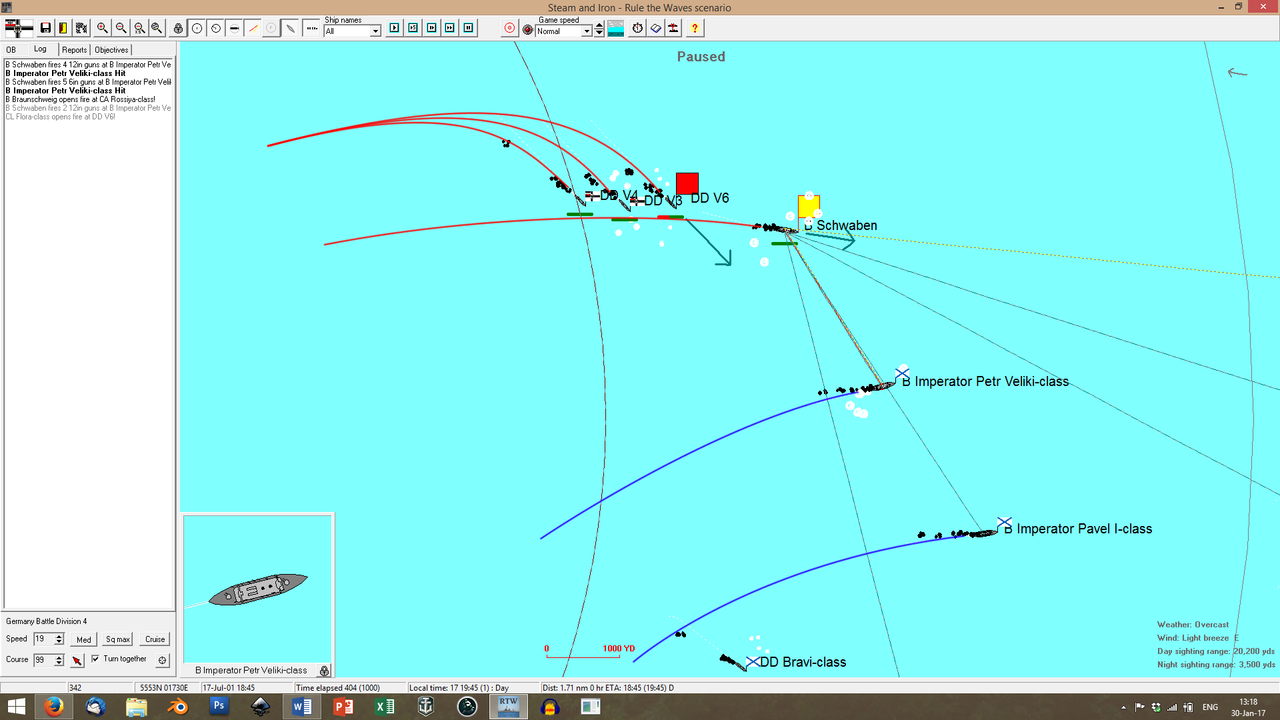
The three destroyers cross the
Schwaben's wake and charge down the
Pietr.
Schwaben keeps up her own fire and scores another main battery hit and a secondary hit on the Russian's superstructure.
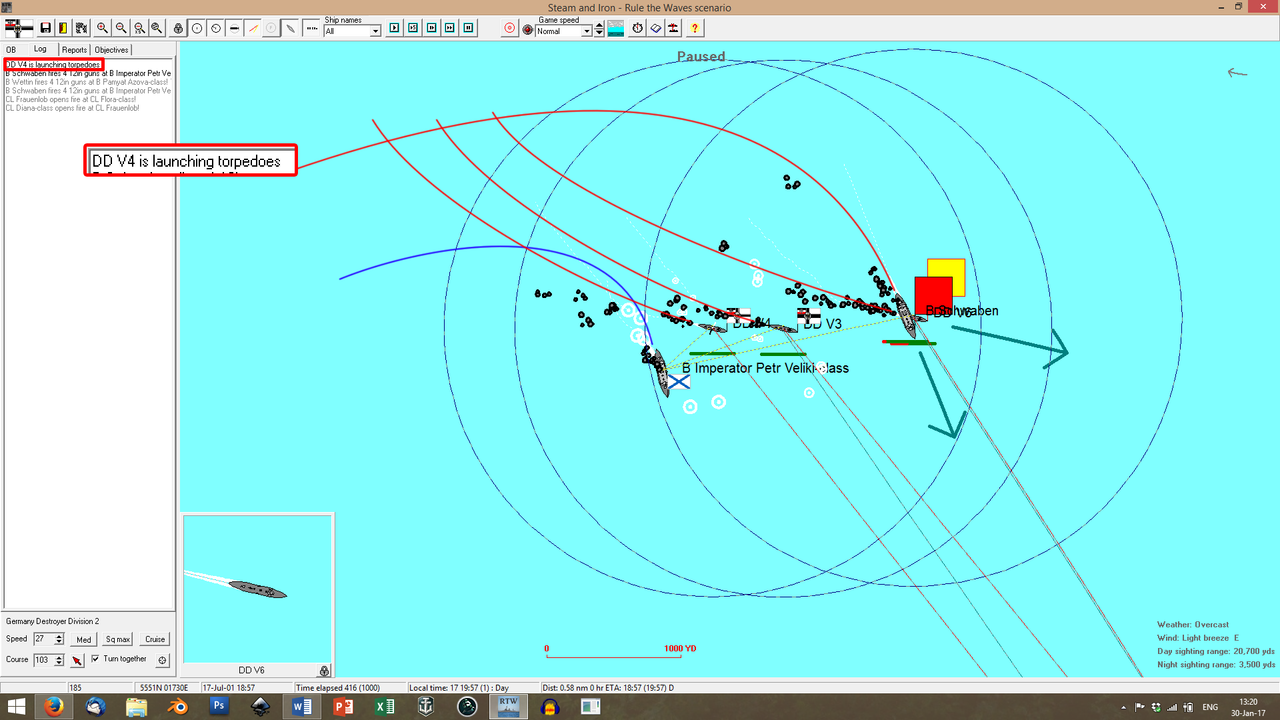
The
Pietr maneuvers wildly to avoid the German ships but, at 500 yards,
V4 launches her single torpedo. The destroyer flotilla then turns away, seeking safety behind
Schwaben's armor.

The torpedo explosion blows a fountain of water sky-high. The
Pietr shudders; her guns fall silent and she slows down even further. The German fleet erupts in cheers.

Galster maneuvers
Hertha next to the hulk and opens up with main and secondary guns; twenty minutes later, the
Pietr slips under the waves.

Büchsel, from on board the
Braunschweig orders
Schwaben and the destroyers to reform with the fleet; but
Schwaben's captain,
Kapitän zur Zee Nikolaus Bernuth, charges in, to
keep the enemy spotted in the gloom. He puts her in a wild serpentine, to avoid incoming fire; and has her secondaries fire star-shells over the enemy ships. The entire fleet converges on her position.
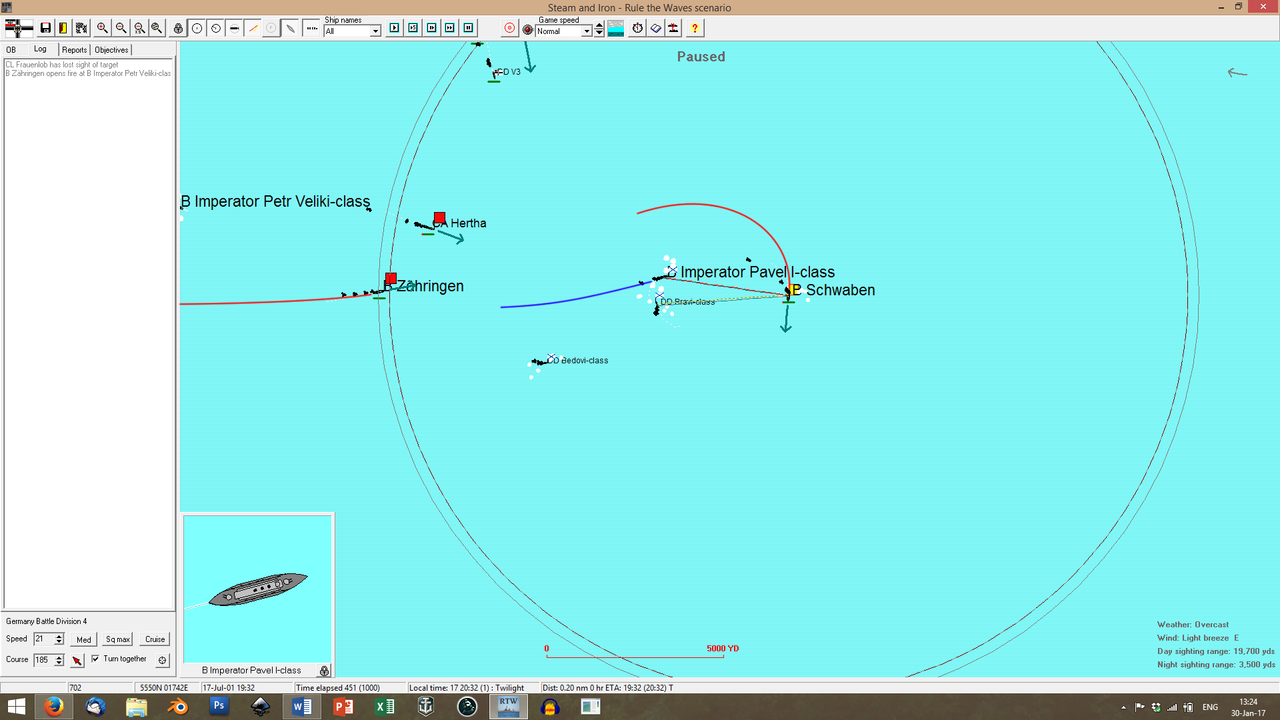 Schwaben
Schwaben then uses her speed to cut in front of one of the
Pavels.
Zähringen and
Hertha are not far behind.

The entire fleet swings past the Russian battleship.
Hertha and
Zähringen score hits with their main armament; and the cruisers completely obliterate her DD escort.
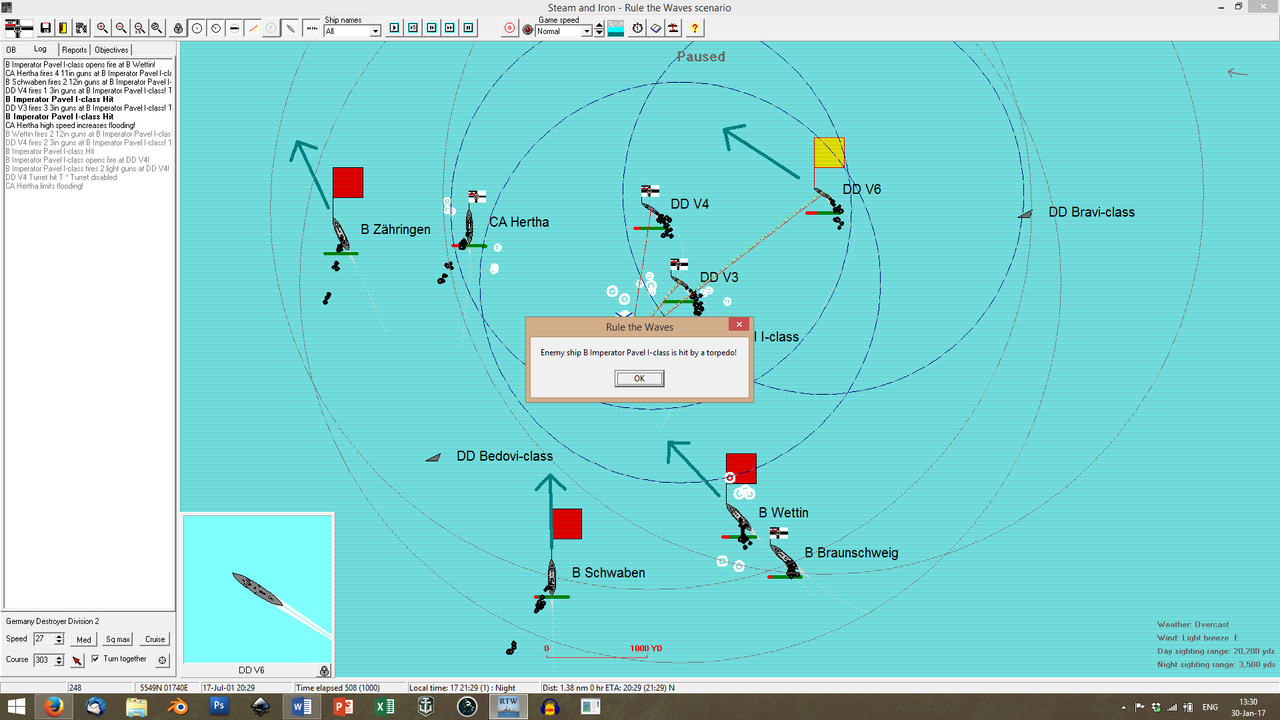
Then, the destroyers move in. V3 launches a torp at close range and scores a hit.
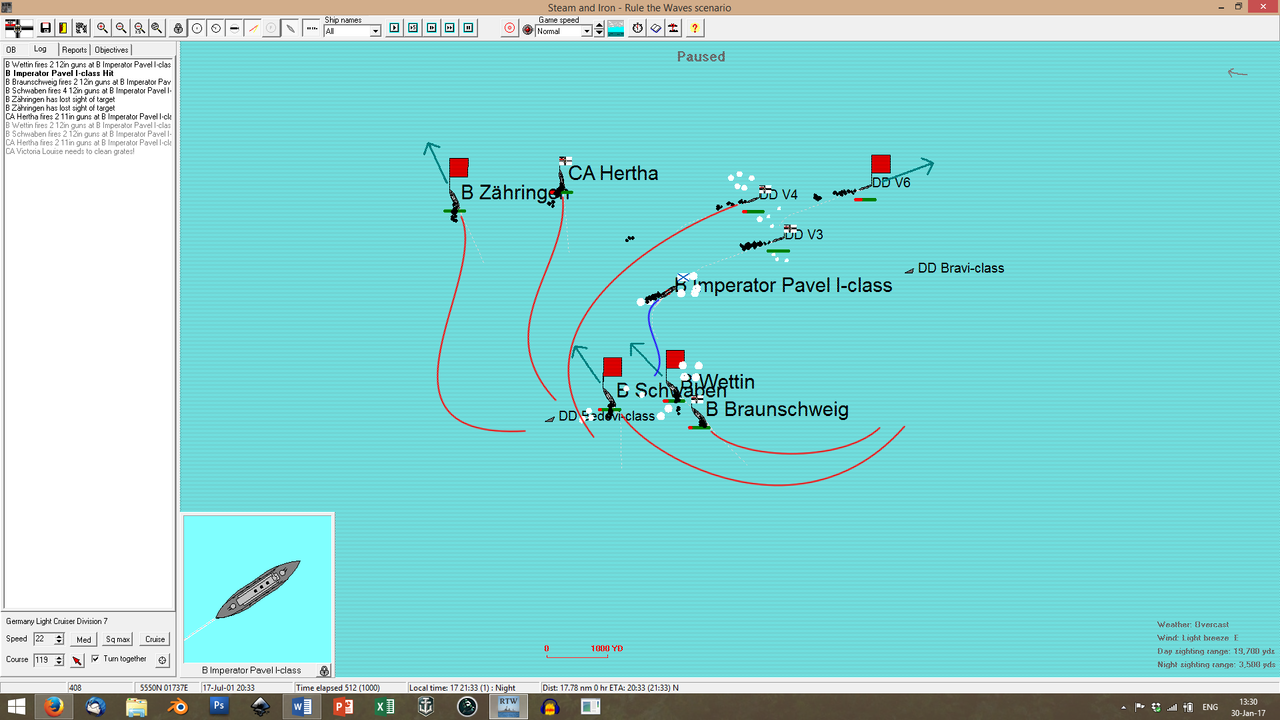
She's still fighting; and she has her own torpedo launchers. The Germans know they've hurt her; they are hesitant to take any risks. Büchsel orders his ships to open the range.
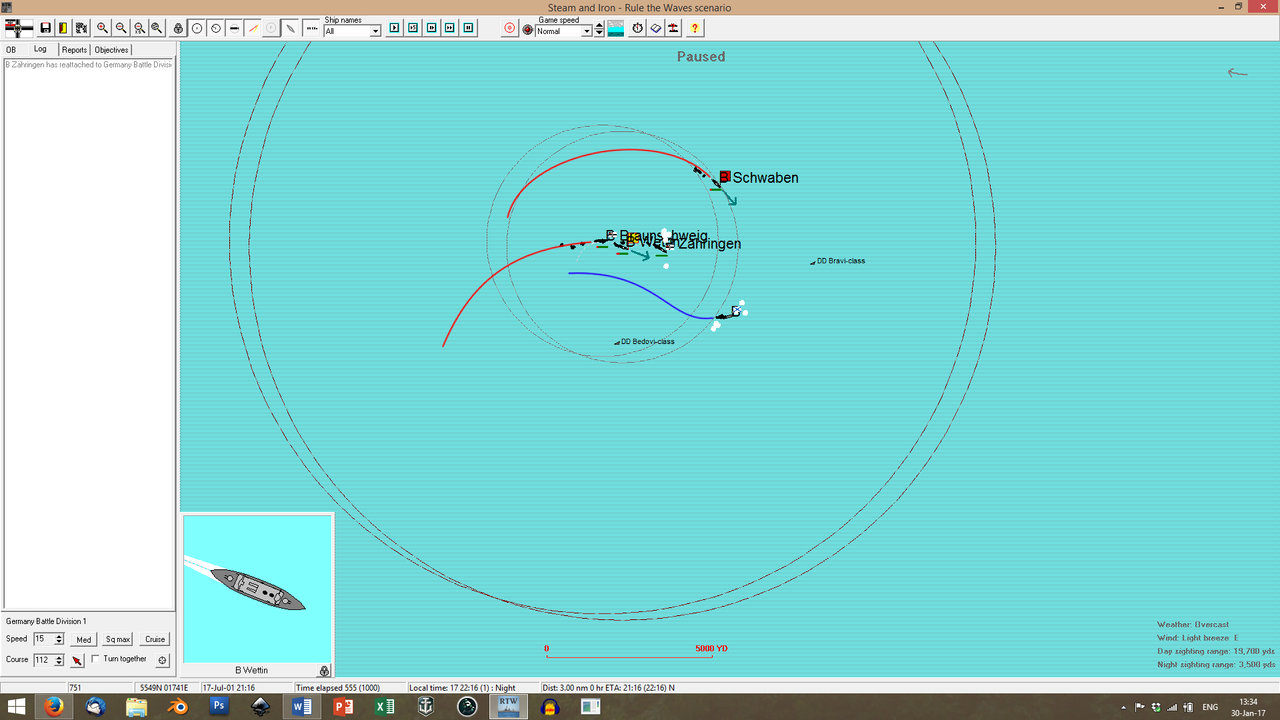
21:16. The
Pavel increases her speed and tries to escape towards the east. The Germans pursue.

It doesn't take long for them to corner her again. She is now completely alone; the rest of the Russian fleet having retreated in the evening gloom.
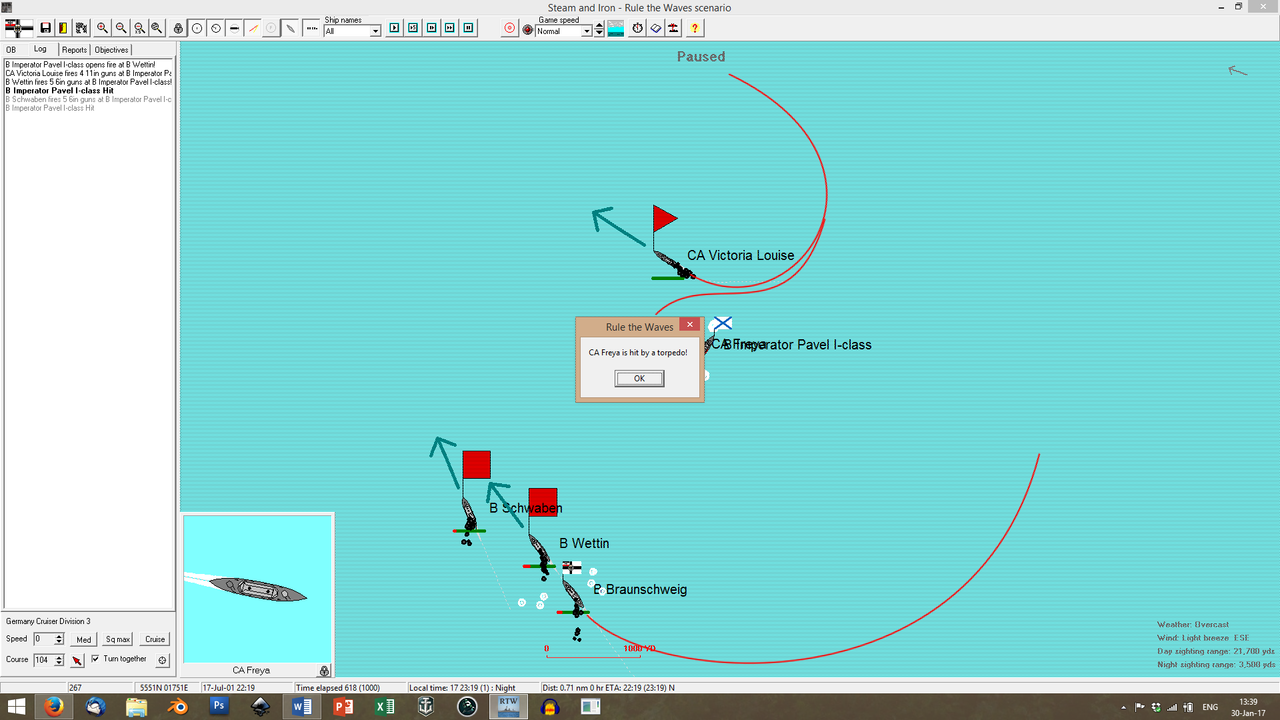
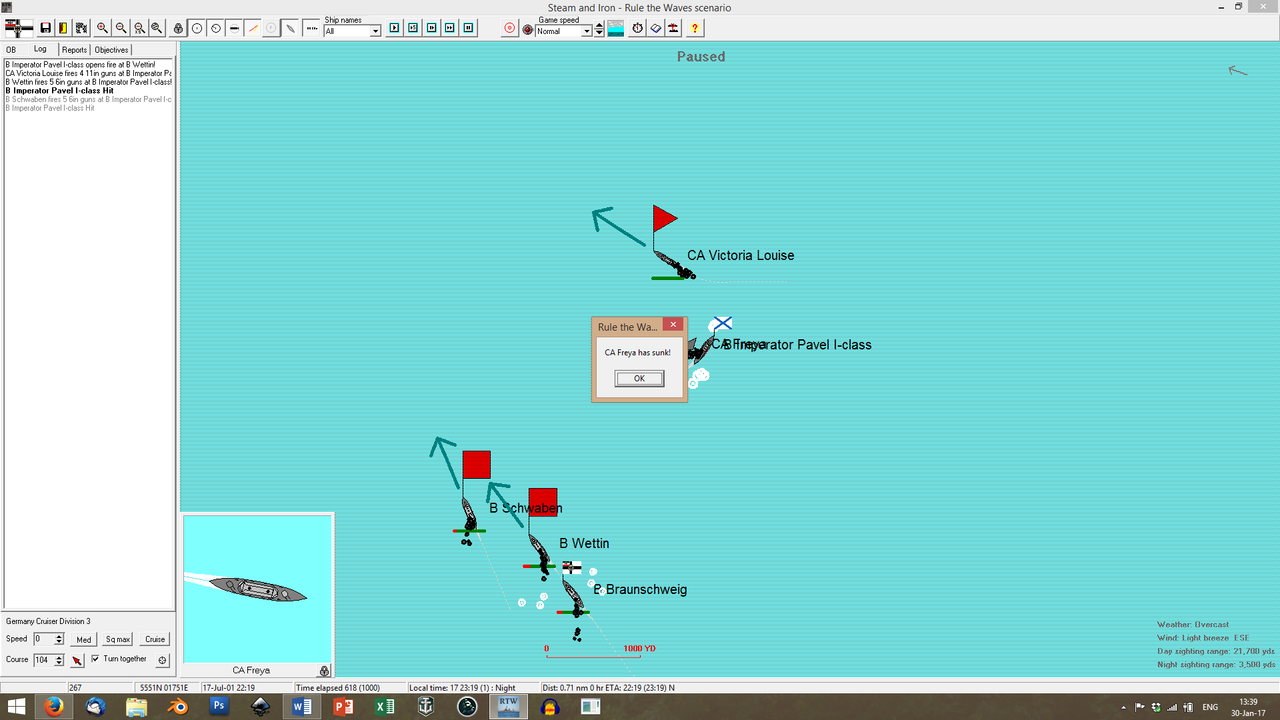
22:19. Disaster strikes. The
Pavel launches a torpedo that strikes the
Freya amidships. Her keel snaps. She lists, flips over and sinks in under a minute.
The Germans are
horrified; Galster more than anyone. In a single fell swoop, he has lost a third of his heavy cruiser fleet; and almost eight hundred sailors and officers.

But Büchsel grasps the opportunity. Knowing that the
Pavel has launched her fish, he closes in with his battleships for the kill.
Schwaben scores two main battery hits; and the
Pavel follows the
Freya to the bottom of the sea.
The fleet turns to return to port-
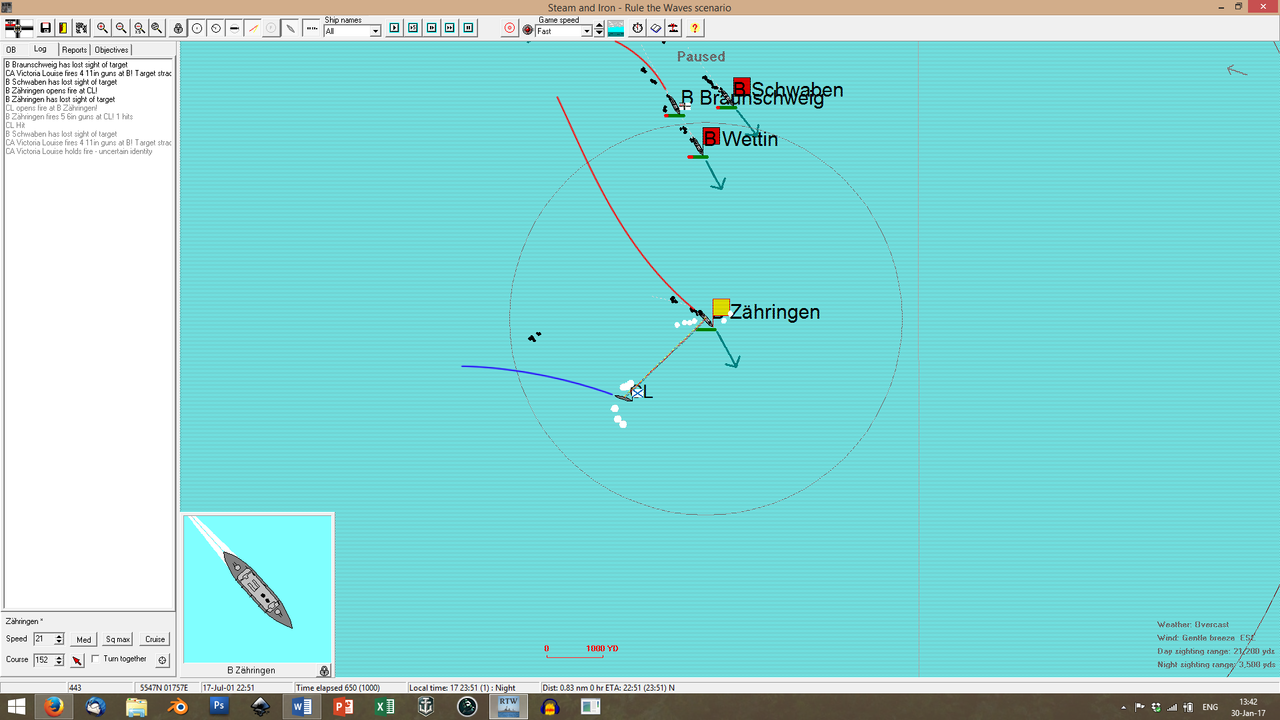
-and then, out of the night, a light cruiser appears on
Zähringen's starboard side. The German battlewagon turns, desperately-
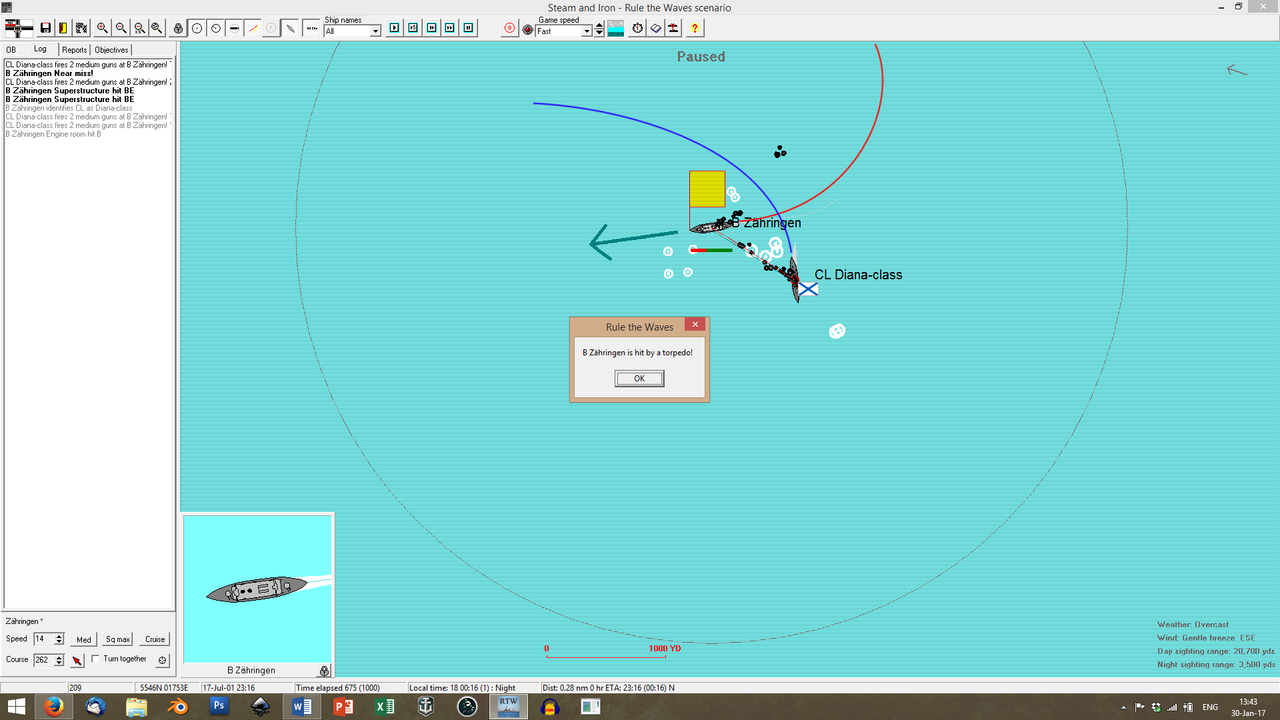
-but to no avail. She eats a torpedo and her superstructure is raked by multiple high-explosive shells before she can bring her guns to bear.
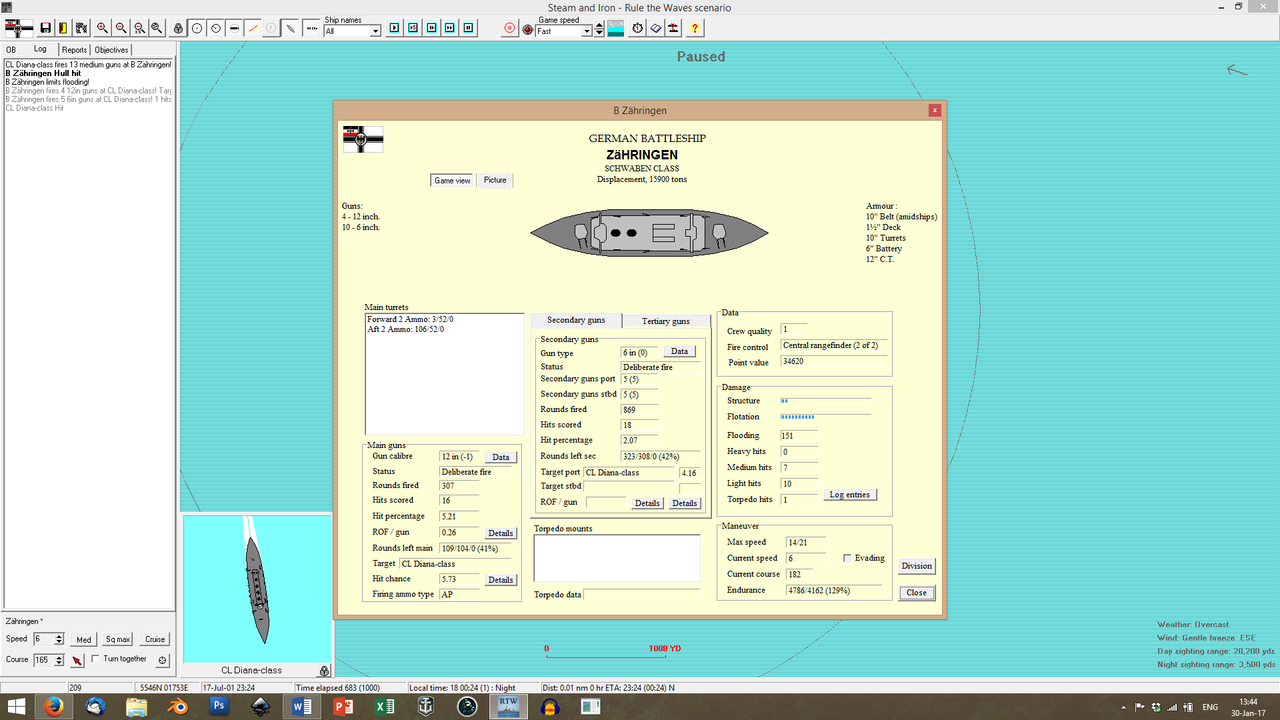
Thankfully, her damcon crews are on-point and her captain orders an emergency stop to avoid stressing the bulkheads. The
Diana turns to bring her other launcher to bear-
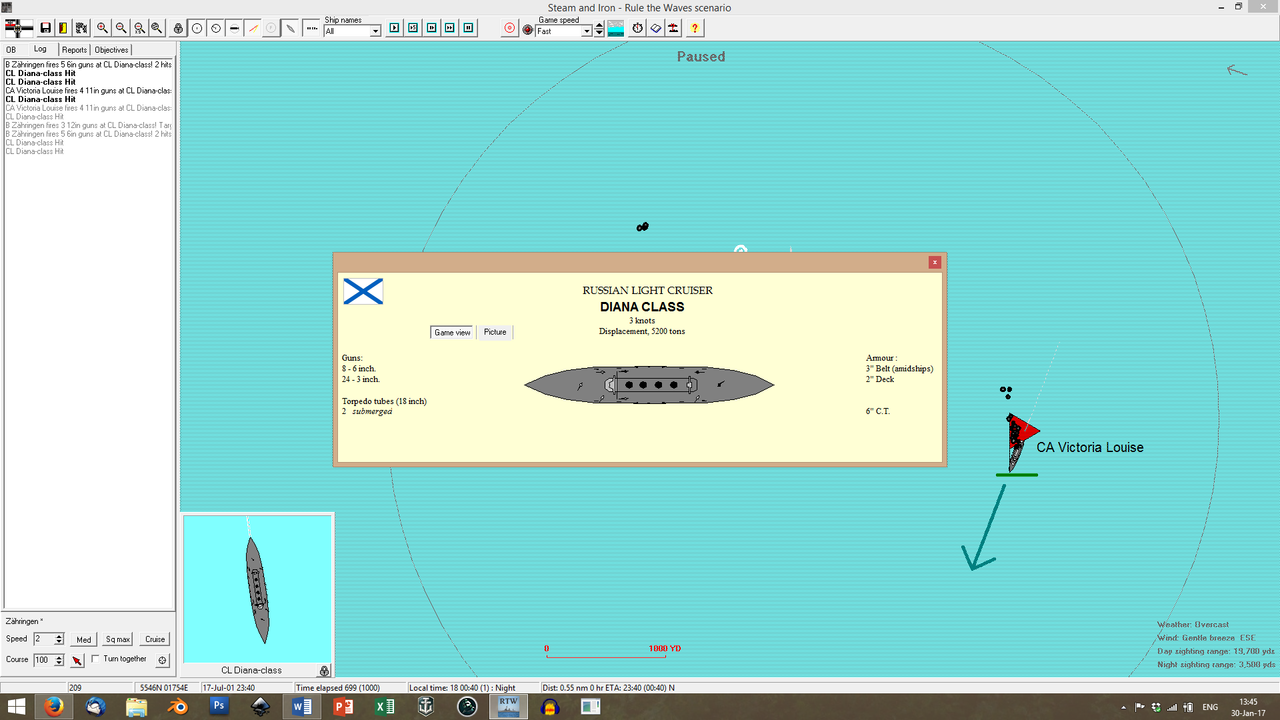
-and is promptly blown out of the water by
Zähringen's secondaries and
Victoria Louise's 11-inchers.
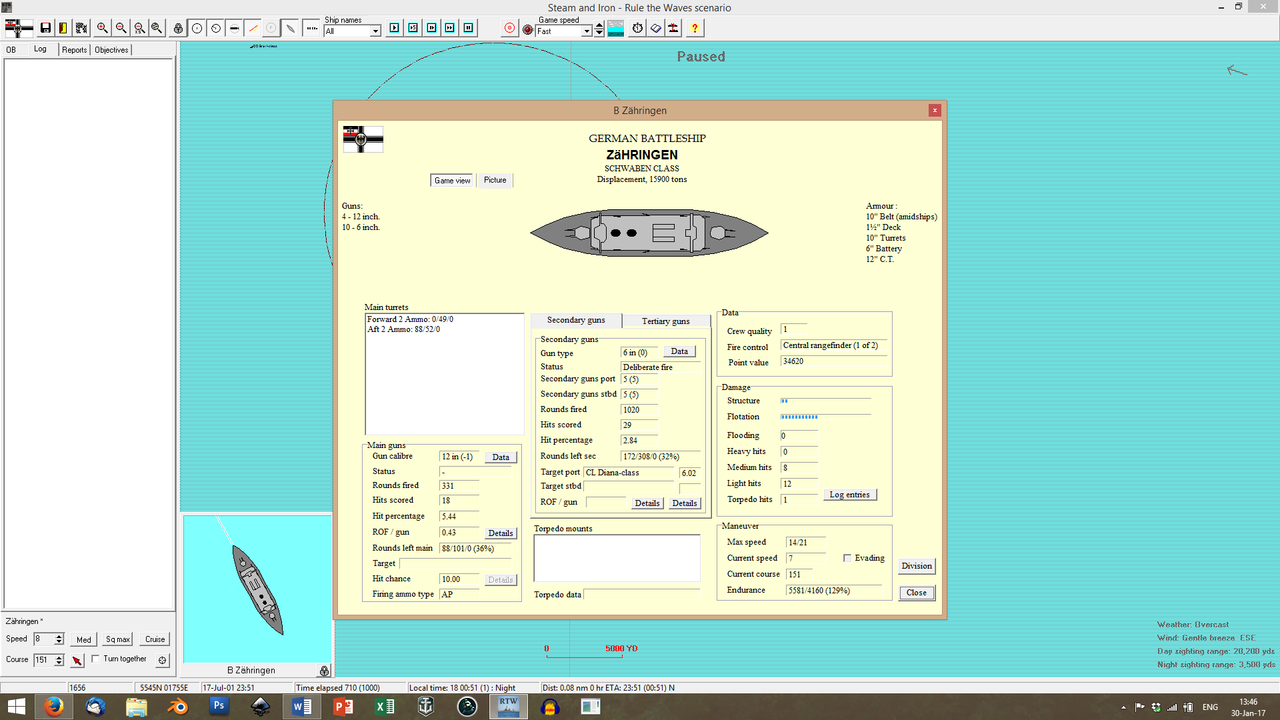
It takes the crew of the
Zähringen less than 10 minutes to stop the flooding. She has suffered considerable damage, but she's still afloat and seaworthy; she can even almost do cruise speed.
At this point, all commanders agree that they cannot expect any better results. They make best steam back to Danzig; the fleet reaches harbor by 6:00 am on the 18th of July.
 The stricken Zähringen after the Bornholmschlacht
The stricken Zähringen after the Bornholmschlacht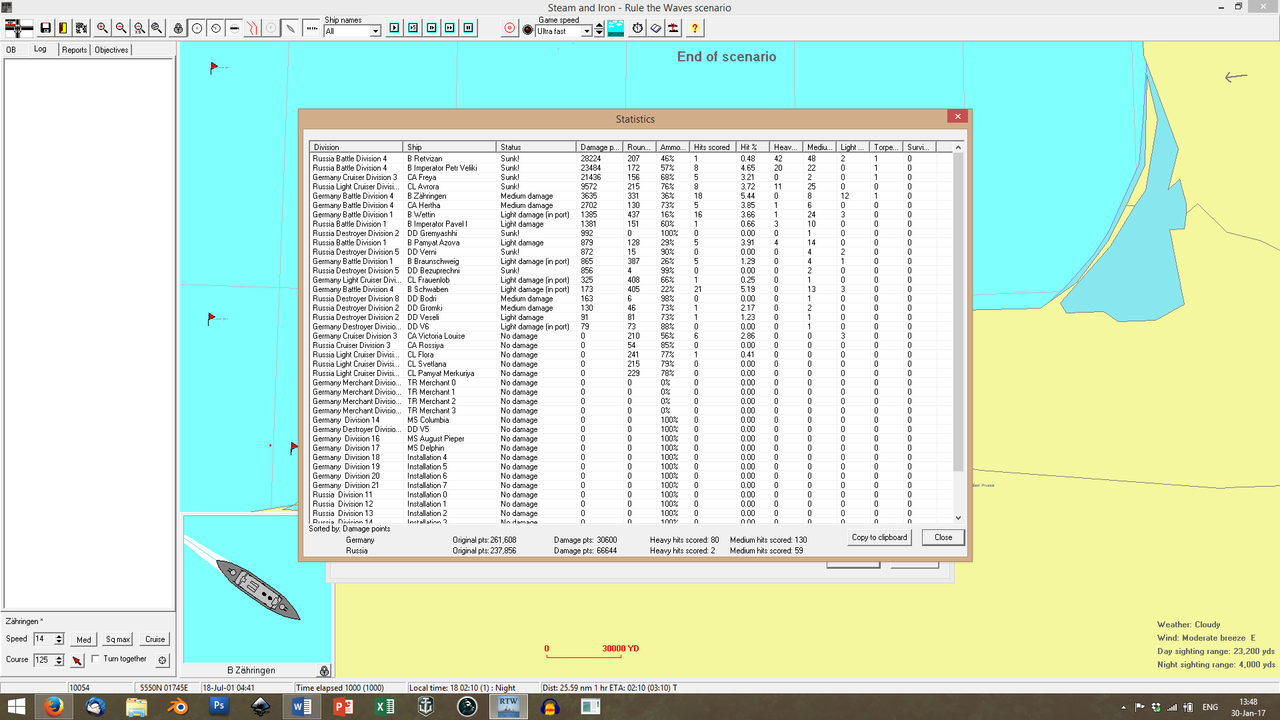
A bloody victory, but a glorious one, nonetheless! Tirpitz strutted like a rooster.
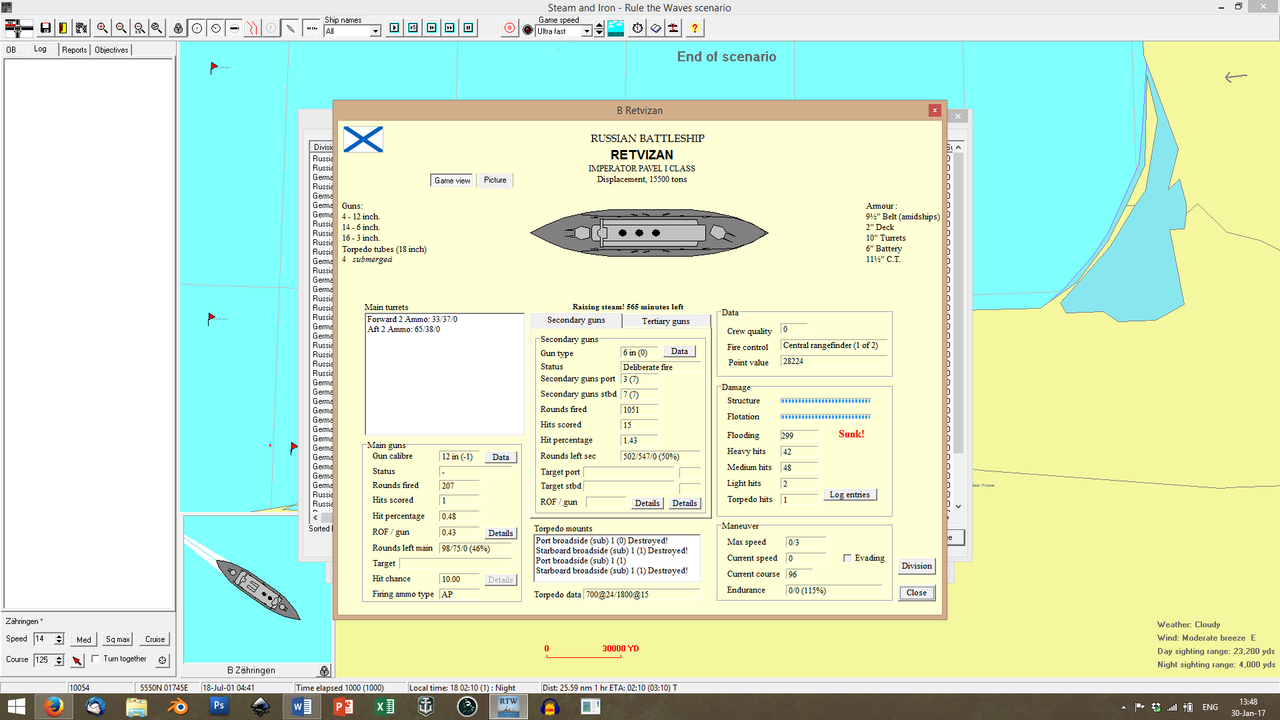
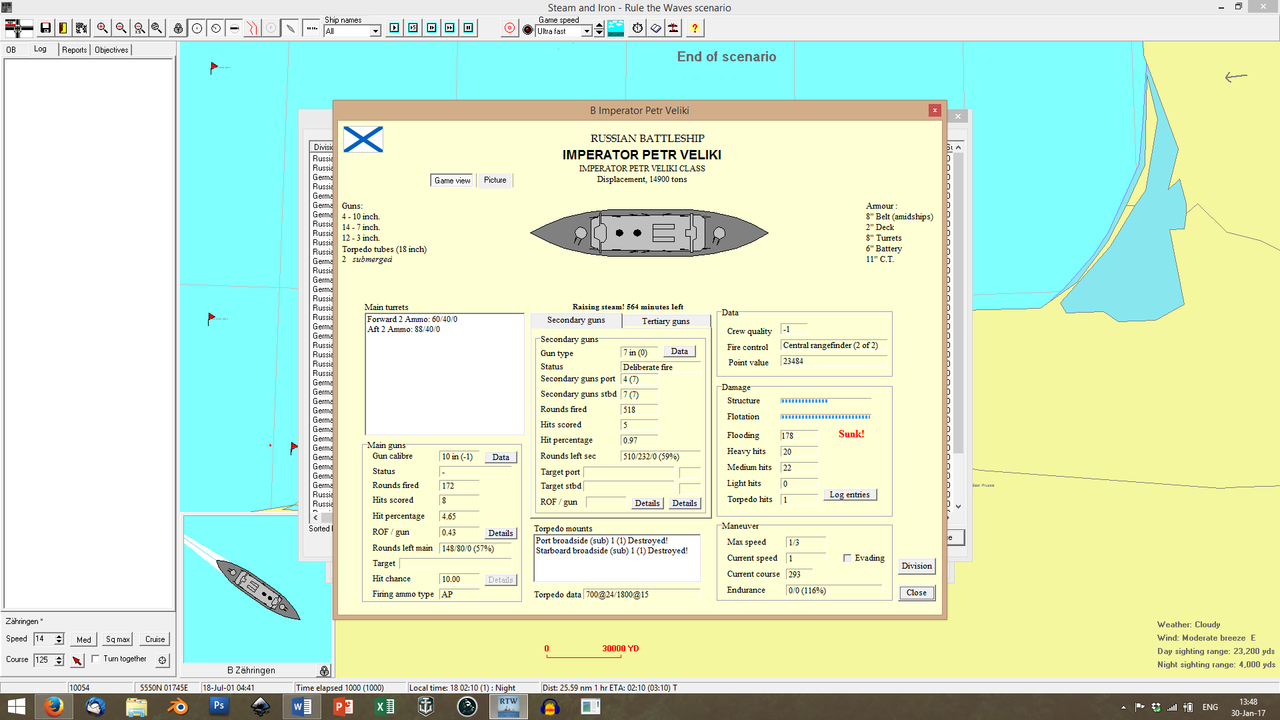
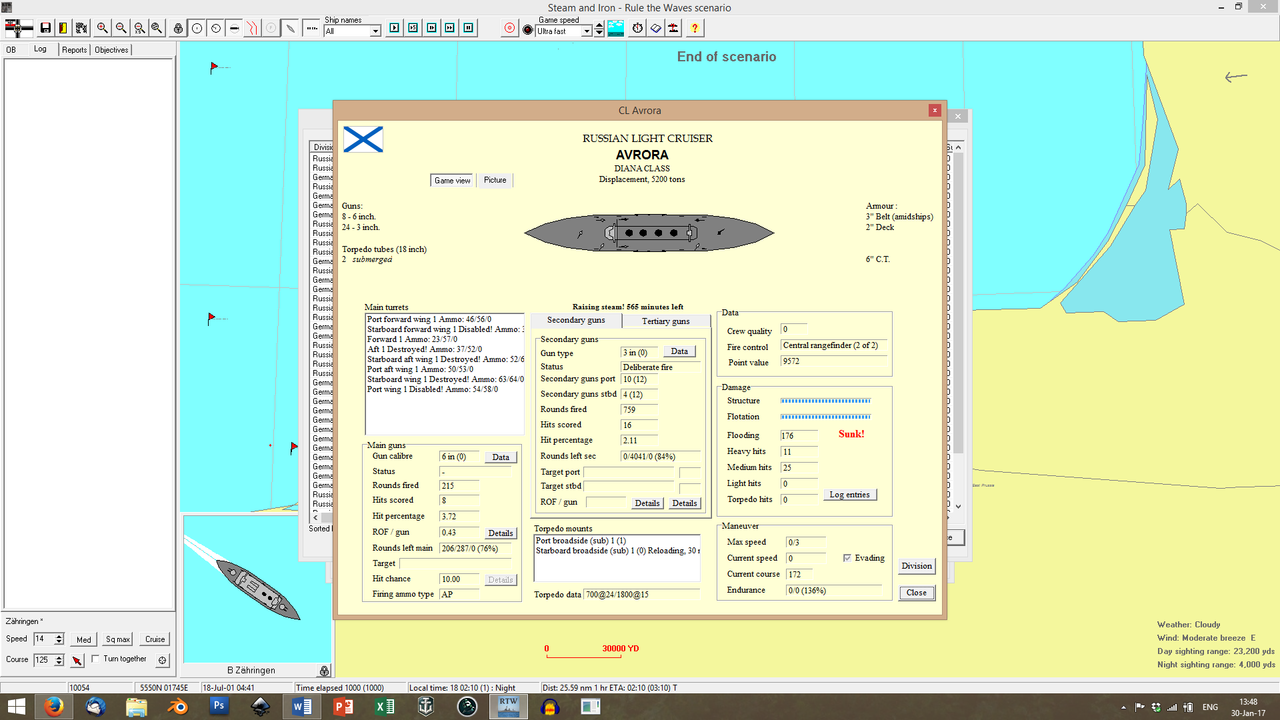
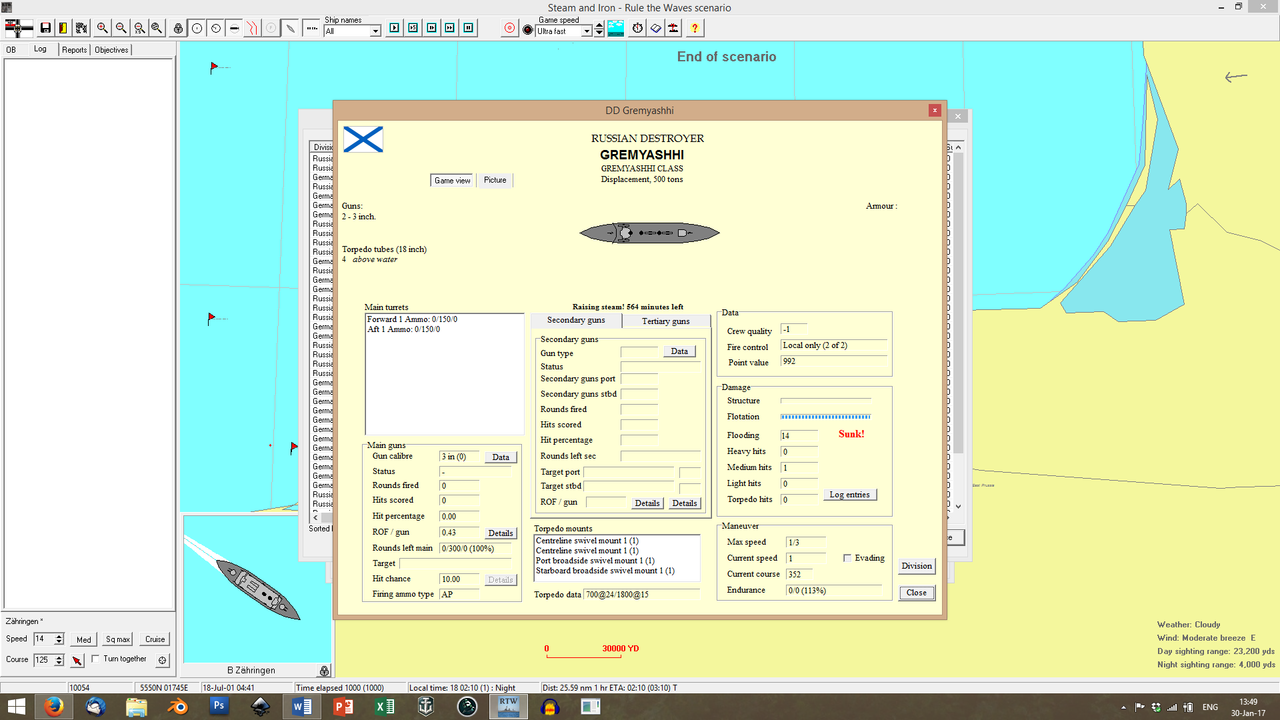
The Russian losses. Two battleships, including the
Retvizan, one of their most modern battlewagons; the light cruiser
Avrora and three destroyers.
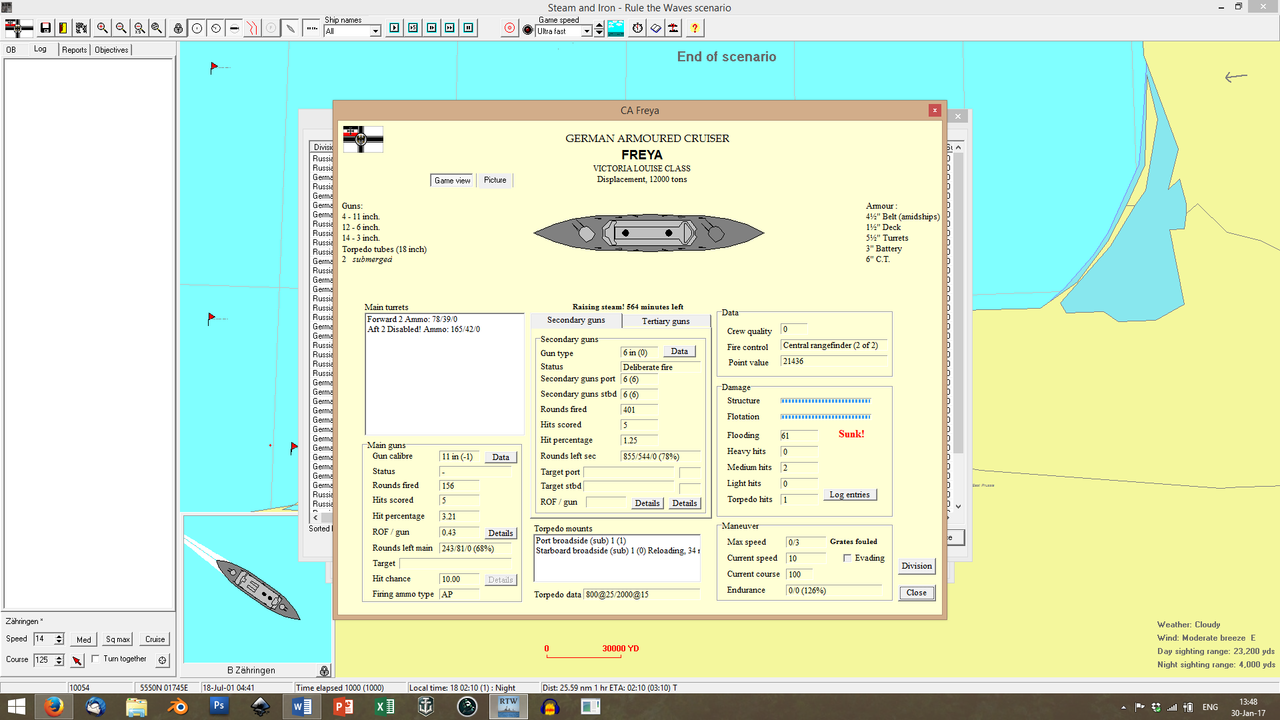
The Germans only lost the
Freya. A grievous loss, true; but a bittersweet one, given the toll they had exacted upon their enemies.

And, this time, the Germans could not complain about their gunnery. The
Zähringen and
Schwaben performed
spectacularly, with more than 700 shells fired between them and almost 40 hits scored.

A more precise map of the ship movements, (for the naval historians - many thanks to the
Admiralitätsarchiv for their kind permission to reproduce this)! Note the two 'knots' near the centre of the map - that's where the two Russian battleships sank.

The Battle of Bornholm! A glorious new beginning for the
Kaiserliche Marine!
